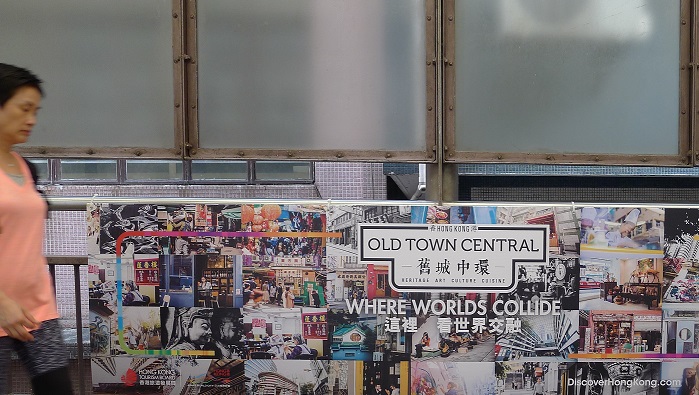Reviews & Articles
文化保育與不擇手段的慈善機構 ∣ Heritage and Unscrupulous Charities
John BATTEN
at 10:18am on 14th June 2017

圖片說明 Caption:
香港旅遊發展局在半山扶手電梯張貼的海報,圖片: 約翰百德
Hong Kong Tourist Board advertising for 'Old Town Central' on the Mid-levels Escalator, May 2017. Photo: John Batten
(Please scroll down for English version)
最近,城市規劃委員會在有關東華三院申請在上環文武廟旁興建21層高青年宿舍的聆訊上,對保育人士的論點表示同意,這對保育人士來說可謂取得一場小勝利。
我說「可謂」,因為我們還有未有看到的故事。在較早前舉行的城規會會議中,東華已獲得興建青年旅舍的批准,但法定規劃程序需要把其正式納入西營盤及上環分區計劃大綱圖。分區計劃大綱圖為地區提供廣泛的規劃方向,而市民對香港任何地區的分區計劃大綱圖有任何書面申述或意見,均可親身在所有城規會委員出席的聆訊上提出。這是一個絕佳且難得的機會,讓公眾以可以直接與決策者會面,更詳細地解釋反對區內某項規劃的意見。
然而,即使城規會是獨立的法定機構,大部份分區計劃大綱圖申請也是由政府帶牽頭,討論時由規劃署解說。城規會推翻規劃署建議,而且不對政策表示支持的情況非常罕見。在這個個案中,東華三院的青年宿舍原本由民政事務局撥款進行,以支持政府為年青人提供更多可負擔住宿的政策。這家青年宿舍原擬於香港重要的法定古蹟文武廟旁的空置小學校舍興建。
所有分區計劃大綱圖聆訊由規劃署簡介申請開始。在這個個案中,規劃署表示傾向贊成有關申請,但提供的支持論據卻出乎意料地少。東華其後簡列了在該處興建青年宿舍的好處。接下來是一眾保育人士,包括我自己,就在文武廟旁興建高樓的申請提出強烈反對。我們表述了文武廟旁校舍所蘊藏的歷史意義、它作為提供教育之處的歷史源流;我們反對在廟旁建高樓,並指出其中一個可能性是當局重塑原有廟宇建築群的單層結構。我們同意香港需要更多青年宿舍,但這次選址卻是錯誤的選擇。此外,文武廟位於地理上敏感的位置,因為最近位於舊中區警署的歷史建築物才發生了倒塌事件,這正是不容忽視的警號。
我們的論據隱約流露一定份量。城規會成員向東華提出了一些尖銳問題:「……為什麼學校現址空置了長達十年時間?」;「……上環是昂貴的區域,如果你根據市值租金六成計算,會不會超出年輕人的負擔?」;「……為什麼新大樓的設計與廟宇格格不入?」我們很歡迎委員提出這些有力問題,因為公眾申述者在呈述後便無權提問。
當日下午時份,我們獲悉城規會同意了我們部份論點,東華需要為青年宿舍計劃重新向城規會申請。這將讓城規會和公眾人士可以在新計劃獲通過興建前重新審閱。
然而,幾天之後,審計署公佈了一份令人震驚的報告,指出有慈善機構以社區用地發展酒店,而不是租金相宜的青年宿舍。報告特別以尖沙咀的香港童軍總會大樓為例。我想,城規會及規劃署必定早知道審計署即將公佈這份報告。除了保育人士不斷努力外,審計署這份證據確鑿的報告,又會否阻止這個在文武廟旁興建青年宿舍高樓的計劃?如果社區用地都可以全用在社區上,而不是用來賺錢,青年宿舍的「迫切需要」就大概不會那麼迫切了!
諷刺的是,香港旅遊發展局在同一時間為一項名為「舊城中環」的宣傳活動揭開序幕。中西區關注組一直都倡議需要保育香港舊城、其佈局和低矮建築的特色。然而,這個歷史悠久的社區內卻不斷出現不合適的發展計劃:文武廟青年宿舍只是其中之一。剛剛宣佈的計劃,還有在禮賓府附近的聖公會用地興建樓高25層的私家醫院;市區重建局也計劃在士丹頓街附近興建兩座高樓,是繼該局對嘉咸街造成的破壞後另一項大計。
對於保育人士來說,任何「勝利」都是短暫的。香港富有歷史的中區無時無刻都備受更大規模破壞的威脅––即使香港旅遊發展局在其最新的推廣活動中對旅客表示舊城很有價值。
詳情請參閱審計署報告:www.aud.gov.hk/pdf_ca/c68ch01.pdf
Translation from the original English by Aulina Chan
原文刊於《明報周刊》,2017年5月13日。
Heritage and Unscrupulous Charities
John Batten
Heritage conservationists – supposedly – had a small victory recently when the Town Planning Board listened and substantively agreed to their arguments at the Board’s hearing on an application by Tung Wah Group Hospitals’ to build a 21-storey youth hostel next door to Man Mo Temple in Sheung Wan.
I say ‘supposedly’, because more can meet the eye. Tung Wah had previously gained approval for their youth hostel at an earlier Town Planning Board application, but the statutory planning process requires that it be formalized by being included on the Sai Ying Pun & Sheung Wan Outline Zoning Plan (OZP). An OZP gives broad planning direction for a district, and any written representation or comment to any of Hong Kong’s district OZPs allows speaking in person to a hearing of the full Town Planning Board. This is an excellent and rare opportunity for the public to directly meet decision-makers to explain in greater detail an objection to the planning of a district.
However, despite the Town Planning Board being an independent statutory body, most OZP applications are government-led and argued in their favour by the Planning Department. It is rare for the Town Planning Board to overturn a recommendation by the Planning Department and not support government policies. In this case, the Tung Wah Group Hospitals’ youth hostel was to be fully funded by the Home Affairs Bureau in support of government policies to provide more affordable youth accommodation. This youth hostel was to be built on the site of an old school currently standing next to Man Mo Temple, a declared monument and possibly Hong Kong’s most important historic site.
All OZP hearings begin with the Planning Department presenting an outline of the application. In this case, the Planning Deprtment was in favour of the application, but it gave surprisingly few supportive arguments. Tung Wah then outlined the merits of a youth hostel on this site. Then followed a group of heritage conservationists, including myself, that strongly argued against the application, outlining the historical importance of the site, its history as a place of education and arguing against a tall building being built directly next to Man Mo Temple, and – rather – it was an opportunity to restore the original one-storey proportions of the historic temple complex. We agreed that Hong Kong does need more youth hostels but this was the wrong site. Furthermore, Man Mo Temple is located in a geographically sensitive area and the recent collapse of a monument-status building in the former Central Police Station was a warning that could not be dismissed.
There was an inkling that our arguments had some weight. Town Planning Board members asked Tung Wah some tough questions: “…why had the school, currently on the site, been left idle for ten years?”; “…the Sheung Wan area is expensive; if you charge 60% of market rent, won’t that be too expensive for young people?”; “…why does the design of the new building not complement the temple?” It was vigorous and welcomed questioning from Board members, as representatives to an OZP do not have the right to ask questions once giving their own presentations.
Later that afternoon, we learned that the Town Planning Board had partially agreed with our arguments and that Tung Wah would need to reapply with a modified plan for a youth hostel. This would allow the Town Planning Board and the public to review a new application before it was approved to be built.
However, a few days later, the Audit Commission publicly released a shocking report about charity groups using their community sites to develop hotels rather, in some cases, lower-priced youth hostels. Particularly highlighted in the report was the Scout Association building in Tsim Sha Tsui. The Town Planning Board and Planning Department must have known that the Audit Commission report was about to be released. Despite the vigorous efforts of all heritage conservationists, was the current plan to build a high-rise youth hostel next to Man Mo Temple curtailed by the damning Audit Commission report? The “urgent need” for youth hostels was not so urgent if community sites could be used for community not money-making initiatives!
Ironically, at the same time, the Hong Kong Tourist Board unveiled a publicity campaign for “Old Town Central.” The Central & Western Concern Group has long advocated that Hong Kong’s old town, its layout and low-rise building character, be preserved. But, inappropriate development plans in this historic area continue: the Man Mo Temple youth hostel is only one plan. Just announced is a 20-storey hospital on the Sheng Kung Hui site overlooking Government House and there are further Urban Renewal Authority high-rise development plans for nearby Staunton Street, adding to their continuing destruction of Graham Street Market.
For heritage conservationists, any ‘victory’ is momentary; Hong Kong’s historic Central district is always under threat of more destruction – despite what the Hong Kong Tourist Board tells tourists in their latest marketing campaigns.
See Audit Commission report: www.aud.gov.hk/pdf_ca/c68ch01.pdf
This article was originally published in Ming Pao Weekly on 13 May 2017
